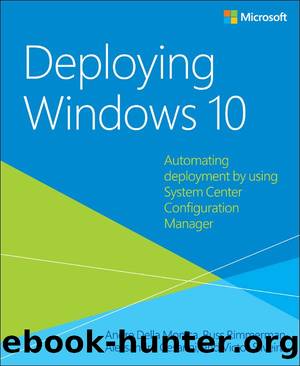Deploying Windows 10: Automating deployment by using System Center Configuration Manager by Andre Della Monica & Russ Rimmerman & Alessandro Cesarini & Victor Silveira

Author:Andre Della Monica & Russ Rimmerman & Alessandro Cesarini & Victor Silveira
Language: eng
Format: mobi
Publisher: Microsoft Press
Published: 2016-03-14T16:00:00+00:00
Figure 3-1: Site system roles for OSD
Following is a description of each of the roles
The Distribution Point (DP) required role provides content during deployments. Types of content consist of applications, software packages, software updates, OS images, and device driver packages. This site system role could be placed in remote office branches to provide clients with a local content source to avoid downloading large content files such as WIMs over the WAN links. Bandwidth throttling and scheduling options are available to control content distribution and, alternatively, a Pull function to enhance bandwidth usage over WAN links. It accommodates network startup if PXE is turned on. If you do want to turn on PXE startup functionality, you will need Windows Deployment Services and a DHCP server with IP helper configurations on network routers.
The Management Point (MP) required role provides clients with configuration and deployment policies and assists in identifying content location for software retrieval based on the clientâs network location. It also receives configuration data from clients and state messages for reporting during a deployment. The MP role typically is located alongside the Primary Site Server, and there can be more than one, depending on the number of clients being managed to distribute the load.
The State Migration Point (SMP) optional role maintains user state data from systems being refreshed or replaced. You can also set the retention period for the userâs data on this site system.
The Software Update Point (SUP) optional role is used to determine which software updates would be applicable to a machine during the build process and throughout the life of the computer while it is managed by Configuration Manager. This site system requires that Windows Server Update Services (WSUS) is installed prior to configuration.
The Fallback Status Point (FSP) optional role provides an alternative method for clients to report any client agent installation or client communicationârelated issues with the MP.
Aside from the site system roles, the Network Access Account is a requirement of OSD for authentication and access to the Configuration Manager environment by clients.
Download
This site does not store any files on its server. We only index and link to content provided by other sites. Please contact the content providers to delete copyright contents if any and email us, we'll remove relevant links or contents immediately.
Grails in Action by Glen Smith Peter Ledbrook(9163)
Sass and Compass in Action by Wynn Netherland Nathan Weizenbaum Chris Eppstein Brandon Mathis(8808)
Azure Containers Explained by Wesley Haakman & Richard Hooper(7444)
Configuring Windows Server Hybrid Advanced Services Exam Ref AZ-801 by Chris Gill(7433)
Kotlin in Action by Dmitry Jemerov(7263)
Running Windows Containers on AWS by Marcio Morales(6985)
Microsoft 365 Identity and Services Exam Guide MS-100 by Aaron Guilmette(5402)
Microsoft Cybersecurity Architect Exam Ref SC-100 by Dwayne Natwick(5212)
Combating Crime on the Dark Web by Nearchos Nearchou(4982)
The Ruby Workshop by Akshat Paul Peter Philips Dániel Szabó and Cheyne Wallace(4671)
Management Strategies for the Cloud Revolution: How Cloud Computing Is Transforming Business and Why You Can't Afford to Be Left Behind by Charles Babcock(4527)
Python for Security and Networking - Third Edition by José Manuel Ortega(4233)
The Age of Surveillance Capitalism by Shoshana Zuboff(4209)
Learn Wireshark by Lisa Bock(4123)
The Ultimate Docker Container Book by Schenker Gabriel N.;(3888)
Learn Windows PowerShell in a Month of Lunches by Don Jones(3681)
DevSecOps in Practice with VMware Tanzu by Parth Pandit & Robert Hardt(3568)
Windows Ransomware Detection and Protection by Marius Sandbu(3543)
Blockchain Basics by Daniel Drescher(3507)
